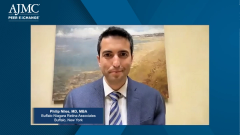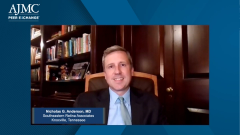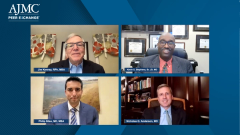
Unmet Needs in the Treatment of Wet AMD
Nicholas G. Anderson, MD; Philip Niles, MD, MBA; Kevin U. Stephens, Sr., JD, MD; and Jim Kenney, RPh, MBA, provide insight on unmet needs and future directions for the treatment of wet AMD and DME.
Episodes in this series

Jim Kenney, RPh, MBA: As we begin to wrap up, what are some of the unmet needs that you’ve identified in the treatment of wet AMD [age-related macular degeneration], if we haven’t already discussed them?
Nicholas G. Anderson, MD: I think efficacy in terms of visual outcomes, we’re hitting a bit of a plateau. It would be great if we could get these patients to 20/20. That may not be realistic on the eye test, but in efficacy, we’re hitting a bit of a plateau. And so, really the name of the game in terms of the clinical trials that we see ongoing and coming up is on durability and further stretching out that treatment interval so patients aren’t coming in as frequently. Anything we can do to get to a consistent 3-month, 6-month, perhaps even longer, treatment interval will be certainly welcomed. We are certainly starting to see some of those potential treatments in the trials right now.
Jim Kenney, RPh, MBA: Anyone else?
Philip Niles, MD, MBA: I agree with everything Dr. Anderson just said. On top of that, I think as a field we’re looking to better exemplify system-level care. Once a patient’s coming to us with diabetic macular edema, things can be further down the road and could have been prevented earlier. I think there’s this recognition by health care professionals in every field that we need to work together a little more to prevent these things from coming up more often. It’s becoming more and more expensive and costly to treat, both from a dollar standpoint, but also in terms of a patient’s health and their ability to maintain their independence. I think that’s where things are headed, hopefully. Right now we’ve got some really good retina doctors who are experts in their field. I think we have some really great health care administrators who can write good policy, but I think that real value left to be had is in the interconnections between these 2 silos right now. I’m hoping we all work together, and hopefully have a better outcome by our interconnections.
Kevin U. Stephens, Sr., JD, MD: I just wanted to reiterate that we as a society need to do things to decrease the disease burden. We are constantly treating, and it’s going to cost more and more. But we have to spend some time, energy, and effort to look at our public health infrastructures, our policies, and see how we can reduce the disease burden. Whether it’s early detection or prevention, particularly in diabetics, we know that the diabetes increases with age, and we know a lot of about it. We can monitor it, we can measure it, and we can manage it. So we need to engage our patients much earlier in terms of having tighter control, and part of it is a society thing. The high fructose diets and all those things, these are readily available, and supersizing it. We all overeat. I think we have some systemic issues that we need to address as a medical community.
On the second hand, we also have to deal with, as we mentioned earlier, costs, the ever-increasing health care costs. This is not just in diabetic retinopathy, per se, but all across, in chemotherapy they have genomics, and they have all kinds of things that just cost more and more. We don’t want to get our health care out of the affordability range. We really have to be very frugal and very conscious and conscientious of costs.
But on the other hand, it’s outcome, the quality of life. As patients, that’s what they look at. “Can I go fishing? Can I see my kids? Can I enjoy the graduation, or marriage of my kids?” We live in a tough time, with the technology, and with the costs, and all these things coming along. It’s fun though. I think the solution is to do like we’re doing now. I really commend and give congratulations to our founders here, to AJMC®, because putting these conversations out there, talking about it, open-door sessions, are creating awareness so that we all can come together and make health care in this world a better place for everybody.
Nicholas G. Anderson, MD: I’ll certainly second that. We’ve talked about macular degeneration and diabetic macular edema here, but the challenges we face in these diseases, as Dr. Stephens alluded to, are not unique. We’re starting to see the same challenges in oncology, the same challenges in neurology. Again, these treatments we have now for macular degeneration and diabetic macular edema are absolutely truly revolutionary. It has completely changed how I care for patients. Our field is so different now than when I trained only 20 years ago.
How do we take these revolutionary treatments and apply them to the individual patient? I think the take-home message for me here is we need flexibility because no 2 of these patients are the same, and what works for 1 patient may not work for another patient. It’s very difficult for us as physicians to take a very rigid protocol and apply it to the patient sitting in front of us. Perhaps the challenge I would put out for the audience, if an audience member is with a payer group, I would challenge you to reach out to your local retina providers and try to set up a meeting. I know in these days it’s hard to set up an in-person meeting. Those are always great, but if not, do a Zoom meeting like we’re doing here. Reach out to them and just have 30 minutes, an hour, and talk to them about these conditions and learn more about them and learn what you can do.
And I would throw out the same challenge to the retina surgeons who are on this meeting. As Dr. Stephens said, you can always find who the medical director is for your region, reach out to them. Too often, we think of the payers as the enemy, or the guys who are just making our life hard, but that’s not the case. We’re all working on the same goals. So ask your practice administrator to invite the medical director for every single-payer group. It’s a lot, it takes time, we’re all busy, but it is well worth your time to sit down for an hour with the medical director and just talk about these diseases, and these programs, and these medications.
Jim Kenney, RPh, MBA: Well, that was great. I want to thank you all for that rich and informative discussion. I also want to thank our viewing audience. We hope you found this AJMC® Peer Exchange to be useful and informative, and we look forward to seeing you on a future program. Thank you all, Dr. Stephens, Dr. Niles, Dr. Anderson. This was a great discussion, and we got a lot of valuable feedback and information that our audience will truly benefit from, so thank you so much.
Transcript Edited for Clarity
Newsletter
Stay ahead of policy, cost, and value—subscribe to AJMC for expert insights at the intersection of clinical care and health economics.







































